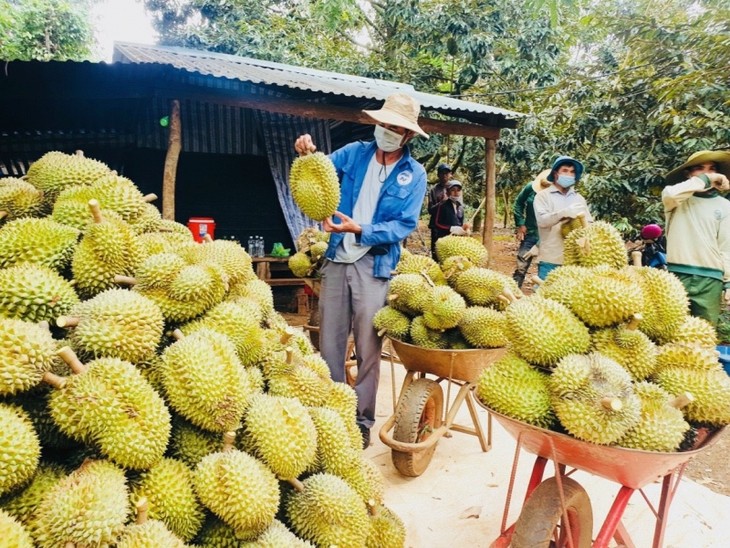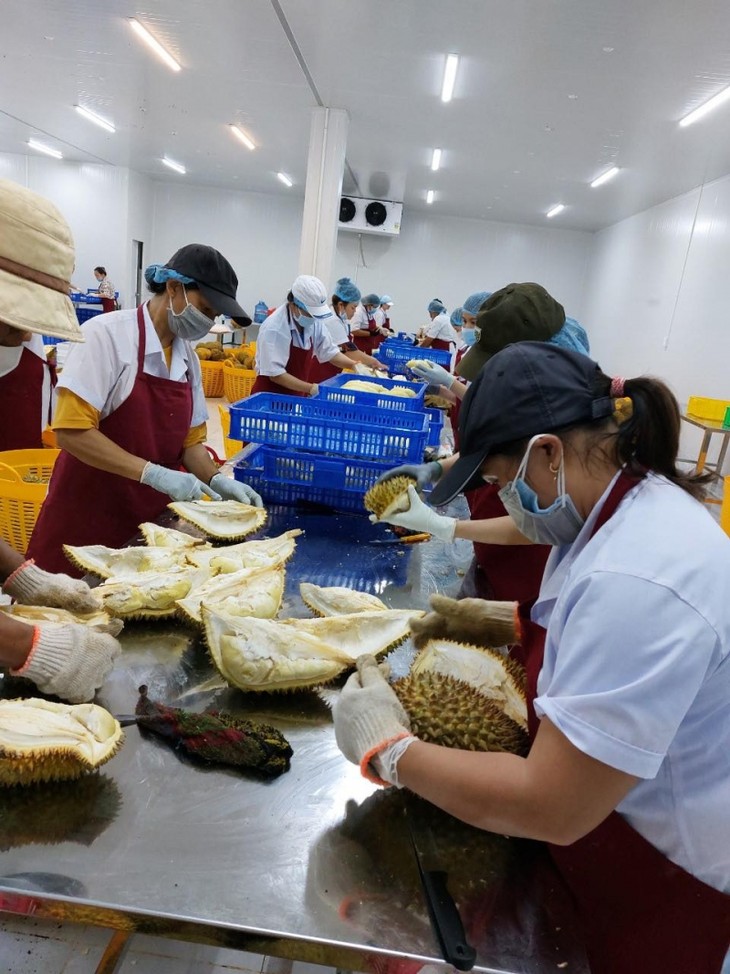(VOVWORLD) - Durian growers in the Central Highlands province of Dak Lak are preparing for this year’s main harvest season, coinciding with the signing of a protocol on phytosanitary requirements for Vietnamese durian to enter the Chinese market via official channels. Tuan Anh has the story.
 Durian is a crop to bring in high economic values for people in Dak Lak province. (Photo: VOV) Durian is a crop to bring in high economic values for people in Dak Lak province. (Photo: VOV)
|
Although the main harvest hasn’t taken place yet, every day traders ask Ms. Le Thi Thanh Thuy of Buon Dung hamlet to sell them the durians she’s growing on her 2-hectare farm.
Thuy says durian prices are increasing day by day and now exceed 2 dollars a kilo, twice the price of the previous crop. The price is high enough to compensate for the productivity decrease due to off-season rains when the plants were in bloom.
Thuy said she hopes that exporting through official channels will help stabilize durian prices.
She told VOV, “My family and all the other farmers are very glad that the protocol was signed. Last year households sold durians for a dollar a kilo, but this year the price has doubled. At this price, we can invest in microbial and organic fertilizers to produce durians that meet export standards. For a long time we just sold to traders and didn’t care where they exported. The price was unstable."
Le Anh Trung, director in charge of the raw materials area of the Dung Thai Son Import-Export Company in Ea Kenh commune says that before the signing of the protocol durians could only be exported through unofficial channels, with many intermediaries, leading to high prices.
“Since 2020 we’ve built raw material areas, obtained 33 planting area codes for 1,160 hectares, and set up 9 packaging facilities, which can meet the purchasing capacity of 200,000 tons per year. To date, we’ve linked with 20 cooperatives with 6,000 hectares of cultivation area and completed the procedures to obtain planting area codes for 2,500 hectares,” said Trung.
 Dung Thai Son Import-Export Company (Photo: VOV) Dung Thai Son Import-Export Company (Photo: VOV) |
Dak Lak now has 17,000 hectares of durian with a total output of 140,000 tons. Each year up to 70% of the province’s durian output is exported to China through unofficial channels.
Krong Pak is one of the districts with the largest durian growing area in Dak Lak, more than 4,000 hectares. Last year, it harvested 50,000 tons.
Ngo Thi Minh Trinh, Vice Chairwoman of the Krong Pak district People's Committee, said that a collective trademark for Krong Pak durian has been granted.
Trinh said, “as soon as Krong Pak’s durian was certified with a collective trademark, we asked farmers to improve the quality of their durian so it can be sold abroad through official channels. The district has instructed local farmers to apply organic farming methods and continue to register planting area codes. An additional 1,040 hectares have been granted planting area codes and we plan to obtain codes for 1,000 more hectares.”
Vu Duc Con, Deputy Director of the provincial Department of Agriculture and Rural Development, said Dak Lak has developed sustainable raw material areas since the protocol was first proposed.
So far Dak Lak has set up 1,500 hectares of concentrated durian growing areas for export and 24 packaging facilities.
Con said, “The growing area and packing facility codes recognized by the Chinese side under the protocol are necessary preconditions. In order for our durian to enter the Chinese market sustainably, we must continuously strive to improve production, packaging, and transport, and comply with the regulations set by the importing country."
To fully tap foreign markets, especially the Chinese market, Dak Lak is doing its utmost to promote its brand, apply advanced technology in durian cultivation, and strictly comply with the protocol’s regulations.